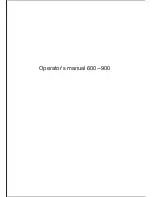
19
Section 3: Adjustments
4/10/19
AP-SR2672, & AP-SR2690 for Skid Steer Powered Rakes 321-004MK
Section 3: Adjustments
Powered Rake Roller
The roller is powered by a roller chain attached to a
sprocket mounted on the hydraulic motor that runs off the
auxiliary circuit of the skid steer loader.
A hydraulic directional valve is utilized to power a
hydraulic cylinder that angles the roller frame 20 degrees
in either direction for windrowing material to the side. This
valve allows 3 gpm of oil to be routed from the auxiliary
circuit of the skid steer loader and is actuated by a
solenoid valve connected to a toggle switch in the cab.
Gauge Wheels
Refer to Figure 3-1:
Caster type gauge wheels control roller height during
field operation. Moving gauge wheels up or down to set
working depth. Do not use skid steer to control roller
height.
1.
Remove linchpin (#5) and washer (#4).
2.
Rotate open end of lower spacers (#3) to align with
notch (#2).
To Increase Working Depth
Pull desired number of lower spacers (#3) from
below the support arm and add to gauge wheel
spindle (#1) above support arm.
To Decrease Working Depth
Pull desired number of upper spacers (#3) from
above support arm and add to notch (#2) below
support arm.
3.
Replace washer (#4) and linchpins (#5).
4.
Repeat above steps 1-3 for the other side.
Depth Adjustment
Figure 3-1
NOTE:
The gauge wheel on the chain case side
should be down approximately 1 inch more than the
non-drive side to compensate for extra weight.
30935
Parallel Linkage Mounting
Refer to Figure 3-2:
The skid steer loader parallel linkage mounting plates
allows the operator to lock the parallel linkage arms in
order to apply down pressure to the rake roller. The pin
can be placed in the back hole to permit parallel linkage
to move in float position. This allows the rake roller with
the aid of the caster gauge wheels to follow the contour of
the ground.
.
Parallel Linkage
Figure 3-2
Material Control Blade Adjustment
Refer to Figure 3-3:
Material control blades are mounted above the roller so
control can be established over both the size and shape
of materials being cleaned or raked. The gap between
the front material control blade and the rake roller can be
adjusted to widen or narrow the opening. A wider opening
will allow more dirt and rock to pass through.
A narrow opening will allow for finer raking.
The height of the front material control blade can be
adjusted by loosening bolt (A) and sliding material control
blade (B) up or down to desired height.
Front Material Control Blade Adjustment
Figure 3-3
30936
Pin Shown in Locked Position
(Locked Parallel Linkage Arms)
Move Pin To This Location Allows Rake
Roller To Follow Contour Of Ground
24534
A
B














































